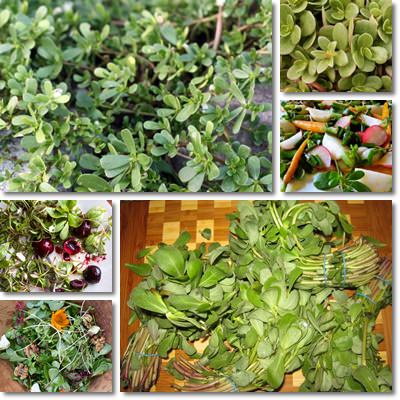Although used since ancient times, purslane is not the most popular cooking vegetable. Its tiny, succulent leaves and stems seem to require too much effort in preparing, while its presence and abundance in gardens, roadsides and yards everywhere causes people to mistake it for an inedible weed.
But purslane is an edible and quite nutritious leafy vegetable and the only issue with it is that we don’t really know how to prepare it or what to pair it with. Enough with the excuses because there’s nothing wrong with or demanding about cooking purslane.
Purslane can be eaten raw, stir-fried, sauteed, made into soup, puree and so on. The fresh leaves and stems have a tangy, sour, salty taste and a pleasant crisp texture, firm and fresh.
Cooked purslane behaves like a slightly more succulent leafy green and tastes somewhat like cooked spinach, patience dock or other similar leafy vegetables. Because it is a surprisingly versatile vegetable, it can be paired with a great variety of other foods, depending, of course, on personal preferences.

From a nutritional point of view, purslane is a healthy vegetable. It is one of the few plants to contain EPA, a form of Omega-3 found only in fish and other marine life species and several animal sources.
But while it’s low in EPA, purslane is rich in ALA, the plant form of Omega-3 fatty acids, essential for good brain activity and cardiovascular health.
Purslane is a great source of vitamin A (1320 mcg), vitamin C (21 mg) and particularly rich in manganese, magnesium, potassium and iron. Regular consumption promotes eye health and boosts immunity, supports innate antioxidant processes and muscle health, helps regulate blood pressure and encourages proper blood oxygenation and red blood cell formation.
Lastly, purslane contains two powerful antioxidants: betacyanins, red pigments that give stems their reddish color, and betaxanthins, yellow pigments found in flowers and leaves. Both antioxidants appear to prevent the formation of various types of cancer as a result of their antimutagenic properties.
How to cook purslane
As healthy as purslane may be, it is an acquired taste and, unless we actually like how it tastes, we’re not going to eat it.
Luckily, there are certain combinations that improve, enhance and perfect the flavor of this succulent vegetable, making it more palatable and encouraging us to enjoy it more often.
Read below and find out the 10 best ways to eat purslane.

10 Different Way To Eat Purslane
1) Purslane, red bell pepper and heirloom tomatoes
Wash a handful of purslane and tap it dry with a paper towel. Discard the thick, woody part of the stems, but keep the tender ones and the leaves.
Chop them finely or simply tear them. Peel and cut one larger cucumber, 1 large heirloom tomato and one large red bell pepper.
Mix together and season with salt and extravirgin olive oil. The good thing about this recipe idea is that all the ingredients are consumed raw and thus preserve their nutritional value, particularly their vitamin C.
2) Purslane, radish, green bell pepper, parsley and goat cheese
Wash, dry and chop about 400 g of purslane leaves and tender stems.
Wash and chop 1 large green bell pepper, 1 medium bunch of radishes and cut about 150-200 g of hard goat cheese into cubes.
Mix together and add half a bunch of finely chopped parsley, drizzle olive oil and season with salt if necessary (the aged goat cheese contains plenty of salt already).
Green bell pepper are rich in vitamin C, parsley has plenty of iron while goat cheese is rich in protein.
3) Purslane, peach, red onions and feta or soft goat cheese
Chop one small red onion and marinate it in a mixture of salt and vinegar until it turns pink. Wash and chop about 200-250 g of fresh purslane, 2 medium-sized ripe peaches, add the chopped onion and about 120 g salty feta cheese (aged, crumbly goat and sheep’s milk cheese) to contrast with the sweetness of the peaches or soft goat cheese to compliment the fruit.
Season with salt, pepper, a tablespoon of vinegar and extravirgin olive oil according to taste.
4) Purslane, zucchini, potato cream soup
Wash and chop 1 bunch of purslane, 3 medium-sized zucchinis (preferably young and tender) and 1 medium-sized white potato.
Boil the potato halfway through. Add the purslane, let boil for 10 minutes, then add the zucchinis.
Once boiled, remove the vegetables and blend them together. Season with salt, pepper and extravirgin olive oil. The potato adds a creamy texture to the soup, and the entire mixture is easy on the stomach and easy to digest.
For more flavor, you can heat a little olive oil in a non-stick frying pan, add a small chopped onion and 1-2 small garlic cloves. Once the flavors are released, mash onions, garlic and olive oil and incorporate into the soup.
5) Purslane, white beans, Parmesan and fennel
In a non-stick pan heat about 300 g of canned white beans with a whole garlic clove and a drizzle of extravirgin olive oil. Clean, chop and mix a bunch of purslane (about 400 g) with 1 diced large fennel stalk and the warmed beans. Season with salt, pepper and olive oil and grate Parmesan.
6) Purslane, arugula, chickpeas
In a non-stick pan, add a half of glass of water and 200-250 g of canned chickpeas (which are already cooked) and heat until the water evaporates.
Transfer to a bowl, add 200-250 g of fresh purslane leaves and tender stems and the same amount of chopped arugula. Season with salt and extravirgin olive oil.
7) Purslane, potato, egg, olives and onion salad
Boil 3 medium-sized white potatoes, peel, cut in quarters and put in a bowl. Add three hard boiled eggs, cut in quarters, 200 g of chopped purslane, a handful of pickled green olives and one finely chopped small red onion.
Season with salt and pepper. You may also add 3-4 tablespoons of a nice home-made mayonnaise, but it will add to the calories and might not complement the olives.
8) Purslane, figs, walnuts or almonds, plums, feta cheese and olive oil and vinegar dressing
In a bowl, mix a bunch (400 g) of purslane with about 120-140 g of crumbled feta cheese (a soft, fresh cheese) and 10-12 ripe figs cut in half. Toast a handful of walnuts or almonds in a non-stick frying pan.
Separately, wilt 10 perfectly ripe plums of a more juicy variety. Mix the walnuts and plums with the rest of the ingredients and season according to taste with extravirgin olive oil and a sweeter balsamic vinegar.
9) Purslane, sour yogurt and chopped mashed garlic
In a bowl, mix about 350 g of sour yogurt (also known as strained yogurt or Greek yogurt) and season with 2-3 cloves of crushed garlic (or as many as you like) and salt. Add about 200-250 g of purslane leaves and mix well.
10) Purslane, onion, garlic, apple saute
In a non-stick frying pan, saute 1 small red onion (chopped) and 1 garlic clove (crushed) for 2-3 minutes. Add 2 cups of purslane leaves and tender stems and 2 medium-sized apples (sliced). Cook until soft, but not mushy.
Any of these can constitute a meal or a snack on their own, but make a delicious and nutritious side dish as well.
The reason why most recipe ideas dictate we use purslane raw has to do with more than their finer taste and texture.
Cooking purslane causes it to loose most of its vitamins, particularly vitamin C, reducing its nutritional value considerably and, along with it, the health benefits we may enjoy from consuming this underdog green.
What does purslane go well with?
Well, we can successfully pair purslane with any of the following: tomatoes, bell peppers, cucumber, zucchini, nuts such as almonds or walnuts, eggs, potatoes, beans, chickpeas, stone fruits such as peaches, plums or nectarines, soft and hard cheeses (feta and Parmesan especially), scallops and fish, duck, lamb, garlic, onions, lemon, cream, olive oil and vinegar, bacon, avocado, couscous etc.
But, Why eat purslane in the first place?
Because it’s healthy. It contains generous amounts of vitamins A and C, but also manganese, magnesium and potassium, as well as B vitamins and powerful antioxidants.
And unless we are completely against green leafy vegetables and their particular greens flavor, these 10 healthy purslane recipe ideas will surely help add variety to any diet and make us appreciate purslane more.
